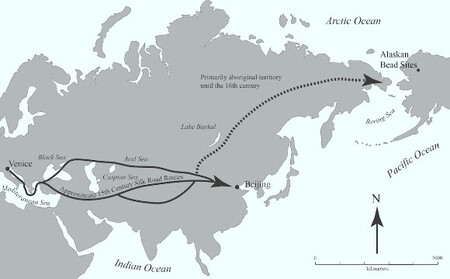When researchers at the University of Alaska Museum of the North they found those glass beads at Punyik Point, an archaeological site on the shores of Lake Etivlik, Alaska, they weren’t too surprised. Yes, it looked like Murano glass; that is, Venetian. But in the last decades of the 20th century, similar pieces had been found in many places (the Caribbean, the Mississippi, the Andean highlands…) as a result of the intercontinental trade that began with the arrival of the Spanish in America.
The surprising thing (what no one expected in any way) happened when they tried to date the deposit.
Can glass beads be dated?. After all, the star dating technique, carbon 14, is based on that, on an isotope of carbon that is found naturally in the world, but is unstable; that is to say, an isotope that gradually disintegrates and that, if it were not constantly replenished (due to natural and human phenomena), would have disappeared a long time ago.
It is a technique that is used with living beings because, through photosynthesis, carbon 14 is integrated into the food chain. This means that, in principle, glass beads cannot be dated with this method, but the string used to join them and form a bracelet can be dated. Or rather, we can date the approximate date of death of the plant that was used to make that string.
That’s when scientists gasped. Because, as he said, it wasn’t particularly unusual to find strange products there: Punyik Point was an old Alaskan trading settlement en route from the Arctic Ocean to the Bering Sea. Not that it was common, but nothing prevented that once the glass beads (and other European products) entered the ports of the East American coast, they would end up arriving in Alaska.
The problem is, when they dated the thread linking three of the accounts, the tests said it had been created between 1397 and 1488. And that, of course, did not add up. The oldest beads ever found (in the vicinity of the Caribbean) dated from the 1550s, but most were from the late 1600s and early 1700s. What was beads like that doing in the Americas decades before the arrival of Colon?
a fascinating journey. After thinking about it a lot (and looking for signs in the nearby deposits that indicated early trade with the areas of America that had direct contact with Europe), the researchers realized that there was only one reasonable explanation. The beads must have traveled east from Venice, traveled the Silk Road, reached the easternmost tip of Eurasia, and then traversed (possibly by kayak) the more than 80 kilometers of open sea separate this continent from America. Later, following the northern trade routes, they would have reached Punyik Point.
Asian and American connections across the Bering Strait have always been a possibility. It was there, in principle, that the first human beings arrived in America and it was there, in principle, that the best geographical conditions were given to build commercial networks that would allow a stable exchange. What happens is that the civilizations that inhabited those latitudes had a not very advanced level of technological development and that has prevented us from finding clear evidence of this.

The appearance of these accounts changes the matter. It doesn’t rewrite anything, of course: but it does give a good account of the fact that the history of the world is much more complex than it seems. And also, much more fascinating.




![[Img #74661]](https://thelatestnews.world/wp-content/uploads/2024/12/The-power-of-ultrasound-150x150.jpg)








![[Img #74661]](https://thelatestnews.world/wp-content/uploads/2024/12/The-power-of-ultrasound-300x200.jpg)


Add Comment